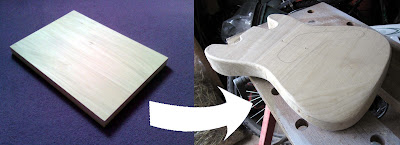Ukuleles are already very portable, but the bumps and bruises of travel can wreak havoc on acoustic instruments. I’ve already constructed a few travel ukuleles. The first was a prototype (Home Depot Travel Ukulele). The second ukulele improved upon the first (DIY Travel Ukulele). Both of these solutions only required basic tools along with common parts and wood.
After slowly acquiring more tools and expertise, I wanted to make another travel ukulele. I took the things that I learned from the other builds and implemented them in this travel ukulele.
I started out by sketching out the design on paper. The scale length was 15 inches (concert scale). There were two tuners on each side using a slotted, classical style.
At a specialty hardwood store, I picked up a beautiful 1.5 in X 5 in (3.8 cm X 12.7cm) piece of hard maple.
The outline and interior were cut with a scroll saw. The overall length of the wood is a little over 20 inches. The widest point is 2.5 inches, and it is 1.5 inches thick.
I slotted the frets, rounded over all of the edges except for the fretboard, drilled all of the holes, and spokeshaved the neck until it was comfortable. The entire assembly was then given a few coats of nitrocellulose lacquer. The lacquer finish really brought out the natural beauty of the wood.
After the strings go over the bridge, they need to be directed back towards the tuners. I used a handful of nylon spacers and washers along with some “Chicago bolts” (I also saw them referred to as “barrel nuts”) to direct the strings.
The bridge is a small aluminium tube that was attached to the body with two metal cable clamps.
A rod piezo was inserted into the rod. The wires from the piezo were fed through a small hole drilled into the jack cavity.
This pickup is very responsive. The combination of the lightweight, but rigid, aluminium and the rod piezo work well together.
The piezo wires were soldered directly to a 1/4 inch mono jack.
It’s ready for strings. I decided to use some of D’Addario’s new T2 Titanium acoustic ukulele strings. They are “bright” sounding strings that are working great for this application. In addition, they are transparent with a pleasant purplish tint which add a bit of razzle-dazzle to the end product.
The travel ukulele is complete. With all of the hardware, it is 20.5 inches long, 3 inches wide, and 2 inches thick. I’m very pleased with how it turned out. I set out to make a sturdy and portable ukulele, and I met my goal. Not only is it a legitimate instrument, it could also fend off zombies, or serve as a cricket bat in a pinch.
To see more of my videos, subscribe to my YouTube channel (Circuits and Strings).

































